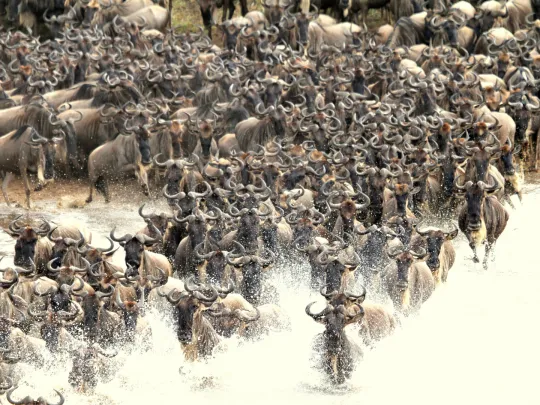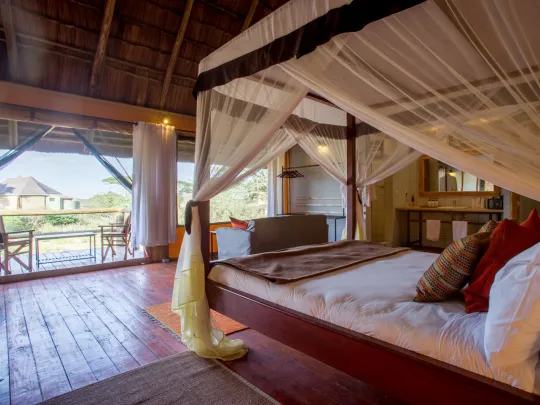Ndutu Area Travel Guide
Ndutu Area Travel Guide
Consisting mainly of sweeping grasslands, the Ndutu area in the northern part of the Ngorongoro Conservation Area joins the Serengeti. As such, it forms part of the annual migratory route of hundreds of thousands of wildebeest, zebra, antelope and their predators who come to graze and calve between November and March, depending on the rains. The forests around Lake Ndutu and small koppies are also home to prolific resident wildlife.
Highlights
- The famous Great Migration settles on the plains from about November to March and April
- Calving season on the plains from December through May is a must-see
- In the dry season from June to November resident elephant, giraffe and big cats gather at waterholes
- All six cat species reside here year-round; leopard, lion, cheetah, caracal, serval and African wildcat
- Prolific birdlife
- Olduvai Gorge; fascinating archaeological site
- Lakes Ndutu and Masek; soda lakes
The Ndutu area forms the northwestern part of the Ngorongoro Conservation area, which covers an area of just over 8,000 km² and includes the spectacular Ngorongoro Crater, the Olduvai Gorge, forests, mountains and the vast plains of Ndutu stretching unfenced to Serengeti.
The Ngorongoro Conservation Area is famous not only for its beauty and wildlife but also for allowing human habitation. The local Maasai tribe still live on subsistence farming within the area. It is not unusual to see a Maasai herdsman with his cows heading over sweeping grasslands dotted with wildebeest and zebra.
Animals of Ndutu
From December to May, depending on the rains, the plains of Ndutu are populated by huge herds of wildebeest, zebra and antelope as they settle on the fertile grasslands to calve. As is to be expected of nature, the predators come in droves, too, feasting on the vulnerable young. It's a smorgasbord of wildlife and the natural circle of life.

Calving season in Ndutu
During the dry season, the plains empty out as the herds move off in search of better water and grazing. There is plenty of resident game, though, that don't follow the migration, including giraffe, elephant, hyena and antelope which tend to concentrate around the waterholes. All six cat species can be found in the area throughout the year; lion, leopard, cheetah, caracal, serval and African wildcat.
Things to see and do in the Ndutu area
- Game drives are especially spectacular when the herds of the Great Migration are on the plains
- Visit the fascinating archaeological site at Olduvai Gorge
- Hot air balloon flight over the plains
- Walk with Maasai guides and learn about local culture and traditions
- Birdwatching
Best time to visit
There is no 'bad time to visit the Ndutu area, as there is an abundance of resident game that doesn't follow the migration route.
If seeing the Great Migration is top of your bucket list, please remember that the movement of the animals is unpredictable and highly dependent on the rains. There is a pattern as to where they move and, based on previous years, an estimate can be made of when they'll be where. The big herds usually arrive on the plains of Ndutu around November and December and move off around April and May.

Cheetah and cub
Speak to our consultants about the best time to go, and where to go, in order to increase your chances of catching it. Do remember that there is always plenty to see, even if you miss the migration!
Getting there
By car - Ndutu is about 280 km from Arusha by road. The trip takes about six hours through beautiful countryside and the Ngorongoro Conservation Area.
By air - There are several airstrips in the area; Ndutu, Seronera and Kusini. Flight time from Arusha to Ndutu Airstrip is just under an hour and daily scheduled flights are available during the high season. Charter flights are also available. Arusha is served by two airports; Arusha domestic airport and Kilimanjaro International Airport with daily flights from local, African and international airlines.
Olduvai Gorge
Two-million-year-old archaeological UNESCO World Heritage site.
Ngorongoro Crater

Ngorongoro is a Tanzanian must-see. The Ngorongoro Crater, a caldera or collapsed volcano, while only covering 260 km², includes a diverse range of habitats including montane forest, grasslands, acacia forests, a salt-lake and swamps. The diversity of the habitat provides refuge to an incredibly wide range of birds and animals, including the Big Five, in a concentrated area. Accommodation around the rim of the crater provides spectacular views and easy access to the crater.
Lake Masek Tented Camp

With raised, beautifully decorated permanent tents placed far enough apart to ensure privacy, Lake Masek Tented Camp offers guests stylish accommodation in the African bush. Its position in the Ndutu area of Ngorongoro, just south of the Serengeti, is on the annual Great Migration route of millions of wildebeest, zebra and antelope, followed closely by predators. Depending on rainfall, the plains are filled with herds between November and May.
Ndutu Safari Lodge
Affordable thatched stone cottages make a good base from which to explore the surrounding area.
Serengeti National Park

Covering a vast area in northwestern Tanzania, the Serengeti National Park is an absolute bucket-list destination. With over 70 mammals, including huge populations of lions and other predators and over 500 bird species, this is a wildlife viewing paradise. Beyond the incredible Great Wildebeest Migration that moves through the area seasonally, the Serengeti is an incredibly beautiful park with diverse flora and fauna.
You may also want to look at

5 Day Luxury Serengeti Safari
Explore one of the Serengeti's most exclusive regions on this 5-day luxury fly-in safari. Based at Olmara Camp in the Soit le Motonyi area of eastern Serengeti, you'll experience exceptional game viewing in a remote, low-tourist zone known for its high concentration of big cats. This safari includes a scenic domestic flight from Kilimanjaro International Airport near Arusha to Seronera Airstrip in the central Serengeti, four nights in an eco-luxury tented camp, and expertly guided game drives in a wildlife-rich area once closed to tourists.

7 Day Taste of Tanzania Safari Tour
This expertly guided 7-day Tanzania safari showcases the very best of northern Tanzania's game-rich parks. From the baobab-studded plains of Tarangire to the world-renowned Ngorongoro Crater and the endless grasslands of the Serengeti, this tour offers exceptional wildlife encounters and a front-row seat to one of the greatest shows on earth—the Great Migration (season-dependent). This is a no-frills, no-fluff journey into the heart of East Africa's legendary wilderness.

Lake Masek Tented Camp
With raised, beautifully decorated permanent tents placed far enough apart to ensure privacy, Lake Masek Tented Camp offers guests stylish accommodation in the African bush. Its position in the Ndutu area of Ngorongoro, just south of the Serengeti, is on the annual Great Migration route of millions of wildebeest, zebra and antelope, followed closely by predators. Depending on rainfall, the plains are filled with herds between November and May.
















